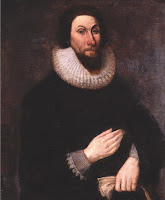Foreword: Family stories are part of the glue that holds generation to generation. At a time when family values are under attacks both bold and subtle, the renewed emphasis on genealogy is a welcome development. During the past four decades my wife, Paula and I have been doing research on our families. Because she can trace her ancestors back five centuries, incidents abound. Here are stories of two men in her direct line worth retelling. Future posts in this vein are anticipated.
Hoare’s mission required him to ride into the hostile Indian camp unarmed and to haggle with the warriors over Mrs. Rowlandson’s release. The inhabitants were anything but welcoming. In her written account of the incident published at the time to great attention in both in America and England, the Rowlandson woman praised Hoare for his “forward spirit.” She described that she initially thought he had been killed in trying to rescue her. In reality, the Indians had simply shot over and under his horse, “pushing him this way and that way, at their pleasure, showing what they could do.” Their intimidation apparently had little effect on Hoare’s resolve to free the captive housewife. Eventually the Indians tired of their sport and were willing to sit down with him to discuss her release.
The story of Hoare’s bravery became well known when Mary Rowlandson published her account of her days in captivity. The story continued to be read for generations. One author said of her book: that it was “long known to every New England family and perhaps secretly read by many a boy in lieu of the present Wild West series....”
Hoare had came to Scituata, Mass., from England about 1643. He subsequently moved to Concord, Mass., where he set up in the practice of law. Although a member of the Puritan Congregationalist Church, Hoare apparently was not a rigid believer. According to one report he was barred by authorities from practicing law for a year for failure to attend church and for making disparaging remarks about a local minister. Hoare also had a reputation for being friendly with Indians, an attribute that might have helped him rescue Mrs. Rowlandson. He built a house for Christian Indians of the Nashobah tribe on his own land, only to have a dozen of his charges kidnapped by local toughs and taken away. John Hoare clearly is a worthy subject for further historical research.
The Trials of Jeremiah Vail: Vail’s birth date and arrival in the New World are not recorded. We know he was living in Salem, Mass., in 1639 and was a blacksmith there. At the time Salem had become the largest community in America occupied by people speaking English. At that date there were only about a dozen scattered groups of white settlers on the whole Atlantic coast and Salem boasted some 1,000 inhabitants.
Vail figures in colonial history because of his involvement in two relatively famous trials. In the first of these that occurred about 1654 Jeremiah was the defendant against a claim by an Indian chief, Wayndanch, the Sachem of Meantaquit, who sued him for damages done to his canoe. According to accounts, the chief was a friend and visitor to Vail’s employer, a man named named Gardiner. The chief often came to see the colonist in a large dug-out canoe. Those boats were made by charring or chiseling out the trunk of a tulip poplar, a laborious process, and were quite valuable.
As the story goes, Jeremiah was told by Gardiner to pull the canoe out of the water and onto land. When he failed to do so in a timely fashion, the canoe was tossed by the current, filled with water, sank and considerably damaged. Gardiner helped Wayndanch sue Vail in the local court where the Indian was awarded compensation of ten shillings. Vail also had to pay one pound, one shilling in court costs. The conviction is accounted as the first time in Colonial history a Native American had ever successfully sued a white man. Interestingly, Jeremiah’s troubles with Indians continued. In 1660 a cow he owned was seized by the town and sold in part to meet the claim of a Pequot Indian for unpaid labor.
Sometime around 1659, possibly affected by the death of his wife, Jeremiah moved to Southold, Long Island, where he owned property. With him were three children, two girls and a boy, 11, also named Jeremiah. Possibly desiring a mother for his children, Jeremiah Sr. married a second wife in Southold a year later. Shortly thereafter she also died. Twice a widower, he would marry a third time. We know only that the first name of this wife was Joyce. Accounted as a “strong. industrious, prudent, and God-fearing man,” Jeremiah died in 1687, about 70 years old. For the next five generations, the eldest son in the Vail line was named Jeremiah, likely a sign of respect for the patriarch.
#####






No comments:
Post a Comment